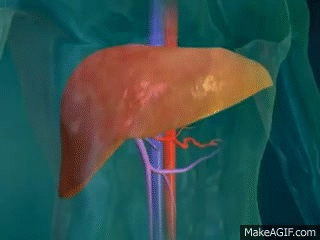- When food enters your mouth its called ingesting food.
- Chewing food is called Mastication.
- Swallow food.
- The teeth that you chew food with is called a molar.
- The teeth that you rip and tear food with is called canines.
- The teeth that you cut food with is called the incisors.
- Our Salivary glands add saliva to the food to help lubricate it.
- The food is "pushed" down the oesophagus by waves of muscle contractions. Longitudinal muscles contract, widening the diameter and shortening the length of the tube. Circular muscles contract behind the bolus pushing it downwards. This process is called peristalsis.
 .
.Digestion
Food Journey Through The Body.
Stomach:
The esophagus leads to the stomach.
The stomach can hold 2 - 4 litres of fluid.
It holds acid which digests food.
The stomach is a large elastic bag that can expand to hold many litres of food.
The PH of the acid is 1 - 2.
The interior of the stomach is lined with holes called gastric pits.
 .
.Small Intestine
Lies between the stomach and large intestine
The PH is between 7 - 9.
Absorption of the nutrients takes place in the small intestine.
The inner walls are covered in small, finger-like projections called villi.
The projections increase the surface area of the small intestine, which increases the rate of the absorption.
Liver:
The liver is the second largest organ in the human body.
A green coloured fluid called bile is produced in the liver.
Average mass of the human liver is about 1.5kg.
The liver detoxifies chemicals and metabolzies drugs.
The liver makes proteins important for blood plasma and other functions.
 .
.Absorption
Egestion
No comments:
Post a Comment
Note: only a member of this blog may post a comment.